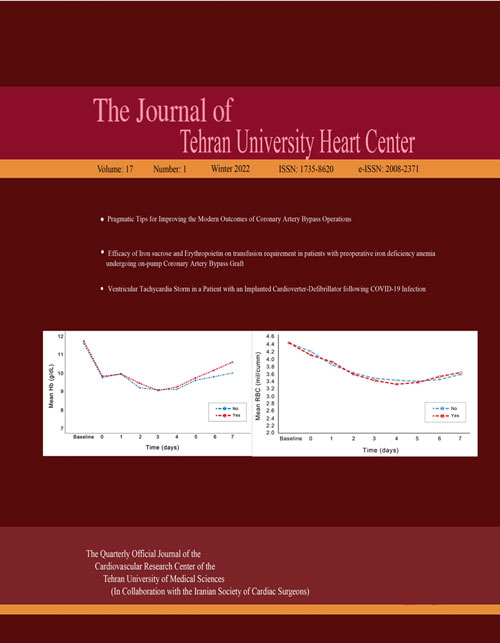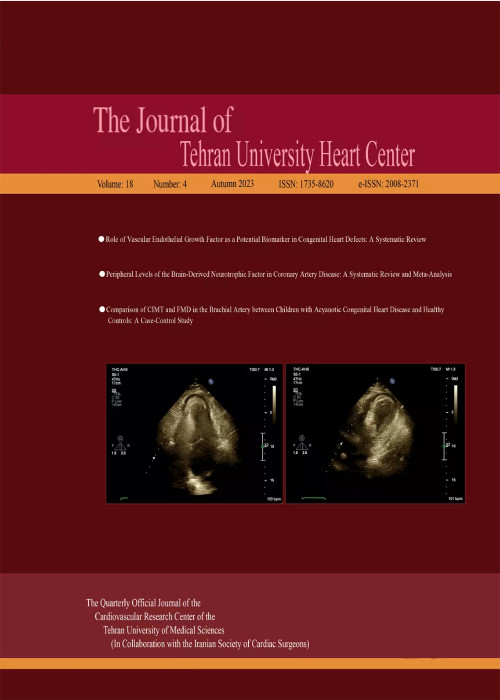فهرست مطالب

The Journal of Tehran University Heart Center
Volume:17 Issue: 2, Apr 2022
- تاریخ انتشار: 1401/04/03
- تعداد عناوین: 9
-
-
Pages 41-47Background
In cardiac surgery, supraphysiological oxygen levels are frequently applied perioperatively. In this study, we examined the postoperative effect of perioperative hyperoxemia in cardiac surgery.
MethodsAll patients who underwent mitral valve replacement via the standard sternotomy method between 2010 and 2021 were analyzed by scanning the hospital data system. The patients were divided into 2 groups: the hyperoxemic group (partial pressure of oxygen/fraction of inspired oxygen [PaO2/FiO2] > 500 mmHg) (Group I) and the normoxemic group (300 mmHg < PaO2/FiO2 < 500 mmHg) (Group II) according to the mean of 3 PaO2/FiO2 values calculated by using 3 PaO2 and 3 FiO2 levels. Postoperative complications, the mechanical ventilation time, the need for noninvasive mechanical ventilator support, the length of intensive care unit (ICU) stay, the hospitalization period, and the mortality rate of the groups were compared.
ResultsA total of 78 patients were included in the study, and 53 of the patients (67.9%) were female. The mean age of the patients was 58.89±12.60 years. The total mechanical ventilation time was significantly higher in the hyperoxemic group than in Group II (P<0.001) (18.18±12.90 h and 11.45±7.85 h, respectively). The amount of postoperative bleeding was significantly higher in Group I (P=0.003) (539.47±201.74 mL and 417.50±186.93 mL, respectively). The total amount of blood products administered during surgery and ICU stay was higher in Group I (P=0.041) (3.55±1.59 units and 2.87±1.89 units, respectively).
ConclusionWe observed that the group with hyperoxemia during cardiopulmonary bypass had a higher amount of postoperative bleeding and the need for transfusion, as well as a longer duration of mechanical ventilation and intensive care.
Keywords: Oxygen, Cardiopulmonary bypass, Morbidity, Mortality -
Pages 48-55Background
In current practice, establishing the potential predictors of high thrombus burden (HTB) before primary percutaneous coronary intervention (PCI) is crucial for its management. In this research, we aimed to investigate the association between vitamin D levels and HTB in patients with ST-elevation myocardial infarction (STEMI).
MethodsThis prospective, observational study was conducted on 257 STEMI patients undergoing primary PCI in Van Education and Research Hospital between March 2020 and March 2021. The thrombus burden grade was determined for each subject. The study population was divided into 2 groups: patients with HTB and those with low thrombus burden (LTB) based on the thrombus burden grade. Demographic, laboratory, and angiographic features were compared between the groups.
ResultsIn total, 154 patients (mean age±SD=63.42±11.53 y, 65.6% male) had HTB and 103 patients had LTB (mean age±SD=61.50±10.23 y, 70.9% male). The patients stratified into the HTB group had lower vitamin D levels than those in the LTB group (8.0 ng/mL vs 17.9 ng/mL, respectively; P<0.001). The patients with HTB and low vitamin D levels had lower post-PCI thrombolysis in myocardial infarction (TIMI) flow, TIMI myocardial perfusion grade, and post-PCI ST resolution. In a multivariable analysis, vitamin D was an independent predictor of HTB among the STEMI patients (OR: 0.76, 95%CI: 0.70–0.82; P<0.001). The ideal value of vitamin D to predict HTB was >17.6 ng/mL with a sensitivity of 81.8% and a specificity of 90.3%.
ConclusionThe study results showed that vitamin D levels were an independent predictor of HTB in STEMI patients treated by primary PCI.
Keywords: Coronary thrombosis, Vitamin D, ST elevation myocardial infarction -
Pages 56-61Background
Current evidence shows inequality in the outcomes of rural and urban patients treated at their place of residence. This study compared in-hospital mortality between rural and urban patients with acute coronary syndrome (ACS) to find whether there were differences in the outcome and received treatment.
MethodsBetween May 2007 and January 2018, patients admitted with ACS were included. The patients’ demographic, clinical, and laboratory data, as well as their in-hospital medical courses, were recorded. The association between place of residence (rural/urban) and in-hospital mortality due to ACS was evaluated using logistic regression adjusted for potential confounders.
ResultsOf 9088 recruited patients (mean age =61.30±12.25 y; 5557 men [61.1%]), 838 were rural residents. A positive family history of coronary artery disease (P=0.003), smoking (P=0.002), and hyperlipidemia (P=0.026), as well as a higher body mass index (P=0.013), was seen more frequently in the urban patients, while the rural patients had lower education levels (P<0.001) and higher unemployment rates (P=0.009). In-hospital mortality occurred in 135 patients (1.5%): 10 rural (1.2%) and 125 urban (1.5%) patients (P=0.465). The Firth regression model, used to adjust the effects of possible confounders, showed no significant difference concerning in-hospital mortality between the rural and urban patients (OR, 1.57; 95% CI, 0.376 to 7.450; P=0.585).
ConclusionThis study found no significant differences in receiving proper treatment and in-hospital mortality between rural and urban patients with ACS.
Keywords: Rural population, Rural health, Urban health, Acute coronary syndrome, Hospital mortality -
Pages 62-70Background
Identifying the long-term predictors of recurrent cardiovascular events may help improve the quality of care and prevent subsequent events. We aimed to investigate the predictors of 1-year major cardiovascular events (MACE) in patients discharged after ST-elevation myocardial infarction (STEMI) in a tertiary hospital in Iran.
MethodsThis registry-based cohort study included consecutive STEMI patients between 2016 and 2019 in Imam-Ali Hospital, Kermanshah, Iran. All patients discharged alive from STEMI hospitalization were followed up for 1 year for MACE, consisting of all-cause mortality, nonfatal MI, and nonfatal stroke. We estimated the hazard ratio (HR) and the 95% confidence interval (95% CI) using Cox proportional-hazard models to evaluate potential predictors, including demographic characteristics, medical history, cardiovascular risk factors, laboratory tests, reperfusion therapy, and medications.
ResultsDuring 2187.2 person-years, 21 patients were lost to follow-up (success rate =99.1%). Of 2274 post-discharge STEMI patients (mean age =60.26 y; 21.9% female), 151 (6.6%) experienced MACE, including, all-cause mortality (n=115, 5.1%), nonfatal MI (n=20, 0.9%), and nonfatal stroke (n=16, 0.7%). Independent predictors of MACE were age (HR:1.02; 95% CI: 1.00–1.04), no education vs ≥12 years of formal schooling (HR: 2.07; 95% CI: 1.17–3.67), stroke history (HR: 2.37; 95% CI: 1.48–3.81), the glomerular filtration rate (HR: 0.98; 95% CI: 0.97–1.00), the body mass index (HR: 0.94; 95% CI:, 0.89–0.99), peak creatine kinase-MB (HR: 1.00; 95% CI: 1.00–1.002), thrombolysis vs primary percutaneous coronary intervention (HR: 1.85; 95% CI: 1.21–2.81), and left ventricular ejection fraction <35% vs ≥50% (HR: 2.82; 95% CI: 1.46–5.47).
ConclusionAge, education, stroke history, the glomerular filtration rate, the body mass index, peak creatine kinase-MB, reperfusion therapy, and left ventricular function can be independently associated with 1-year MACE.
Keywords: Myocardial infarction, Mortality, Morbidity, Risk factors, Stroke -
Pages 71-74
Congenital anomalous coronary arteries (CACAs) comprise an important variant of the coronary vasculature. They are benign in the vast majority of cases, whereas a small minority may be affected by serious consequences such as myocardial infarction, arrhythmia, cardiac arrest, and even death. We herein describe a 62-year-old man with sudden and severe substernal chest pain; Q waves in electrocardiographic leads II, III, and aVF; and positive serum troponin I enzyme. Left heart cardiac catheterization revealed triple coronary vessel disease with a 60% to 70% occlusion in the left main coronary artery (LMCA). The left anterior descending (LAD) and the left circumflex artery arose from the ostium of the right coronary artery. Additionally, a rudimentary type IV dual LAD originated from the LMCA. A coronary artery bypass graft surgery was performed using a left internal mammary artery graft for the LAD and a saphenous vein graft for the diagonal branches (I & II) of the LAD and the posterior descending artery. The patient was discharged after an uneventful 1-week hospital course.
Keywords: Coronary vessel anomalies, Coronary vessels, Angiography, Cardiac catheterization -
Pages 75-77
An accessory mitral valve (AMV) is a rare anomaly of the mitral valve (MV) that often causes left ventricular outflow tract (LVOT) obstruction. We describe a young woman presenting with infrequent palpitations to our outpatient clinic. She was evaluated for mid-systolic murmur at the left sternal border. At the initial transthoracic echocardiography, vegetation on the MV was suspected. The patient was referred to our advanced echocardiography lab, where transesophageal echocardiography revealed an AMV with mild LVOT obstruction. The findings, along with extensive laboratory tests, ruled out vegetation. Additionally, she had a bicuspid aortic valve. At follow-up after 1 year, the patient was asymptomatic regarding the AMV with LVOT obstruction, and the repeat echocardiography depicted no changes compared with the previous echocardiography. Distinguishing AMVs from other MV masses, including vegetation, sometimes poses a challenge and can lead to unnecessary diagnostic and therapeutic measures. This rare MV anomaly is associated with bicuspid aortic valves.
Keywords: Mitral valve, Endocarditis, Heart defects, congenital -
Pages 78-81
Injuries to the heart and great vessels should always be considered after blunt chest trauma. Valvular damage rarely occurs after blunt trauma, but symptoms may be delayed. A 58-year-old woman was referred to our hospital with exertional dyspnea (functional class III) and palpitations for elective transesophageal echocardiography. Her symptoms had exacerbated in the preceding 2 or 3 months. Physical examination showed holosystolic murmurs (IV/VI) at the lower sternal border with extension to the apex. Transesophageal echocardiography revealed avulsion of the base of the posterior mitral valve leaflet (P3) from the annulus. In the past medical history, there was a history of a motor vehicle accident 9 months earlier. The patient was recommended for mitral valve surgery. Mitral valve replacement was performed, and the diagnosis was confirmed by surgery. The patient was discharged without any complications.
Keywords: Mitral valve insufficiency, Thoracic injuries, Myocardial contusions -
Pages 82-85
Kawasaki disease (KD) is a febrile vasculitis and is considered a leading cause of acquired coronary artery disease in children. A clinically critical complication is the coronary artery aneurysm, which may progress and lead to coronary stenosis or even obstruction. Herein, we describe a 14.5-year-old boy with a history of KD at 6 months old, who developed multiple aneurysms along all the coronary branches. During the follow-up at the age of 14 years, the left coronary artery aneurysms regressed, while the aneurysm of the right coronary artery persisted and was complicated by obstruction at its proximal part, according to computed tomography angiography. However, the patient at the last follow-up was asymptomatic and well. The serious nature of KD coronary complications warrants follow-up visits. Since echocardiography alone may fail to reveal stenosis or obstruction, other adjunct follow-up imaging modalities such as conventional, computed tomography, and magnetic resonance angiography should be performed in patients with coronary aneurysms.
Keywords: Mucocutaneous lymph node syndrome, Coronary aneurysm, Coronary stenosis


